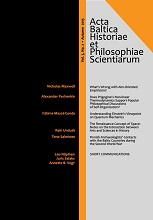The Renaissance Concept of Space: Notes on the Interaction between Arts and Sciences in History
The Renaissance Concept of Space: Notes on the Interaction between Arts and Sciences in History
Author(s): Rein UnduskSubject(s): Philosophy of Science
Published by: Tallinna Tehnikaülikooli õiguse instituut
Keywords: fiction; infinity; knowledge; non-Euclidean geometry; space;
Summary/Abstract: The “Renaissance concept of space” harbors surely some definite bonuses for anybody embarking on a study of the inventive role that philosophy has had, in its happiest moments of life, for human cognition. First, the new suppositions related to physical space emerge in the Renaissance as derivative from the theological-philosophical assumptions of the era: what Renaissance space is can be enunciated quite convincingly on the basis of the intellectual collisions that the era was allotted to deal with. Thus, as a re-generator of classical culture, the Renaissance had to a degree dug up the finite substructure of ancient thinking; however, as an inheritor of the Middle Ages, it had been requested to square finitism with transcendency. Second, much of what we can today fit under Renaissance space is in fact delivered to us in the artistic form of painting, which means that, in addition to the challenge set by philosophy to the spatial knowledge of the era, there was postulated as well a mediatory agency of art in the realization and conveyance of this new knowledge. Thus we can suppose that the solution offered by Renaissance art to the problem of space on its fictional plane comprised the germ of some modern knowledge about space in reality.
Journal: Acta Baltica Historiae et Philosophiae Scientiarum
- Issue Year: 3/2015
- Issue No: 2
- Page Range: 66-81
- Page Count: 16
- Language: English

